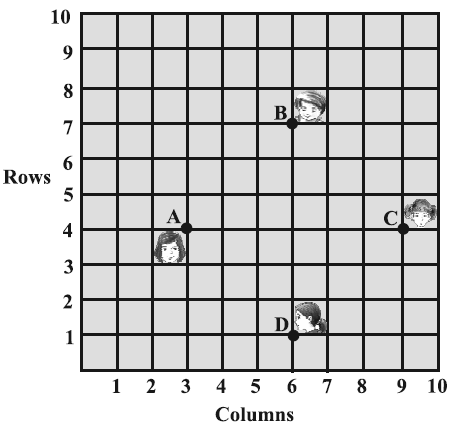FINDING DISTANCE BETWEEN TWO POINTS EXAMPLES
Subscribe to our ▶️ YouTube channel 🔴 for the latest videos, updates, and tips.
Let (x1, y1) and (x2, y2) be the two points as shown below.

Then, the formula for the distance between the two points is
√[(x2 - x1)2 + (y2 - y1)2]
Examples
Example 1 :
Check whether (5,-2) (6,4) and (7,-2) are the vertices of an isosceles triangle.
Solution :
Let the given points as A(5,-2) B(6,4) and C(7,-2)
Distance between two points = √(x2 - x1)2 + (y2 - y1)2
Length of the side AB :
Here, x1 = 5, y1 = -2, x2 = 6 and y₂ = 4
= √(6 - 5)2 + (4 - (-2))2
= √12 + (4+2)2
= √1 + 36
= √37
Length of the side BC :
Here, x1 = 6, y1 = 4, x2 = 7 and y₂ = -2
= √(7 - 6)2 + (-2 - 4)2
= √12 + (-6)2
= √1 + 36
= √37
Length of the side CA :
Here, x1 = 7, y1 = -2, x2 = 5 and y₂ = -2
= √(-5 - 7)2 + (-2 - (-2))2
= √(-12)2 + (-2 + 2)2
= √144 + 0
= √144
= 12
AB = BC
Since length of two sides are equal, the given points are the vertices of a triangle.
Example 2 :
In a classroom 4 friends are seated at the points A,B,C and D as shown in figure given below. Champa and Chameli walk into the class and after observing for a few minutes champa asks Chameli,"Don't you think ABCD is a square?" Chameli disagrees. Using distance formula, find which of them is correct.

Solution :
It can be observed that A (3, 4) , B (6, 7), C(9, 4) and D(6, 1) are the position of these 4 friends.
Length of AB :
Here, x1 = 3, y1 = 4, x2 = 6 and y2 = 7
= √(6 - 3)2 + (7 - 4)2
= √(3)2 + (3)2
= √9 + 9
= √18
= 3√2
Length of BC :
Here, x1 = 6, y1 = 7, x2 = 9 and y2 = 4
= √(9 - 6)2 + (4 - 7)2
= √(3)² + (-3)²
= √(9 + 9)
= √18
= 3√2
Length of CD :
Here, x1 = 9, y1 = 4, x2 = 6 and y2 = 1
= √(6 - 9)² + (1 - 4)²
= √(-3)² + (-3)²
= √9 + 9
= √18
= 3√2
Length of DA :
Here, x1 = 6, y1 = 1, x2 = 3 and y2 = 4
= √(3 - 6)² + (4 - 1)²
= √(-3)² + (3)²
= √9 + 9
= √18
= 3√2
Length of diagonal AC :
Here, x1 = 3, y1 = 4, x2 = 9 and y2 = 4
= √(9 - 3)2 + (4 - 4)2
= √62 + 02
= √36
= 6
Length of diagonal BD :
Here, x1 = 6, y1 = 7, x2 = 6 and y2 = 1
= √(6 - 6)2 + (1 - 7)2
= √02 + (-6)2
= √36
= 6
It can be observed that all the sides of this quadrilateral ABCD are the same length and also the diagonals are of the same length.
Therefore, ABCD is a square. Hence, Champa was correct.
Subscribe to our ▶️ YouTube channel 🔴 for the latest videos, updates, and tips.
Kindly mail your feedback to v4formath@gmail.com
We always appreciate your feedback.
About Us | Contact Us | Privacy Policy
©All rights reserved. onlinemath4all.com

Recent Articles
-
10 Hard SAT Math Questions (Part - 40)
Dec 25, 25 08:30 AM
10 Hard SAT Math Questions (Part - 40) -
10 Hard SAT Math Questions (Part - 41)
Dec 24, 25 07:58 PM
10 Hard SAT Math Questions (Part - 41) -
ASTC Formula in Trigonometry
Dec 23, 25 11:34 PM
ASTC Formula in Trigonometry - Concepts - Examples and Solved Problems


